Viewing: social contract
January 7, 2018
Supporting Students’ Choices
Hello, families! One of my focuses this year has been helping students to make the best possible choices in class. As a group, we’ve been working to curtail side conversations, increase direction following, and improve the amount of respect in the classroom. In early December, I launched some new approaches, and I’m so happy to say that these have been very helpful in making our classroom a more focused, kind, and positive space for learning. These new approaches include three parts:
Our Goals
Like every other class at PGS, we have a social contract that outlines how students and teachers want to be treated by one other. While it has many important qualities included in it, I found that it lacked the specificity needed to give us precise goals. For example, the idea of respect was included in our social contract, but it didn’t outline what respect is, what it looks like, how it makes us feel, etc. So, through some discussions with students, I developed a new set of goals for our class. Before you look at it, let me warn you: It looks like a lot. But in fact, it’s not as complicated as it seems.
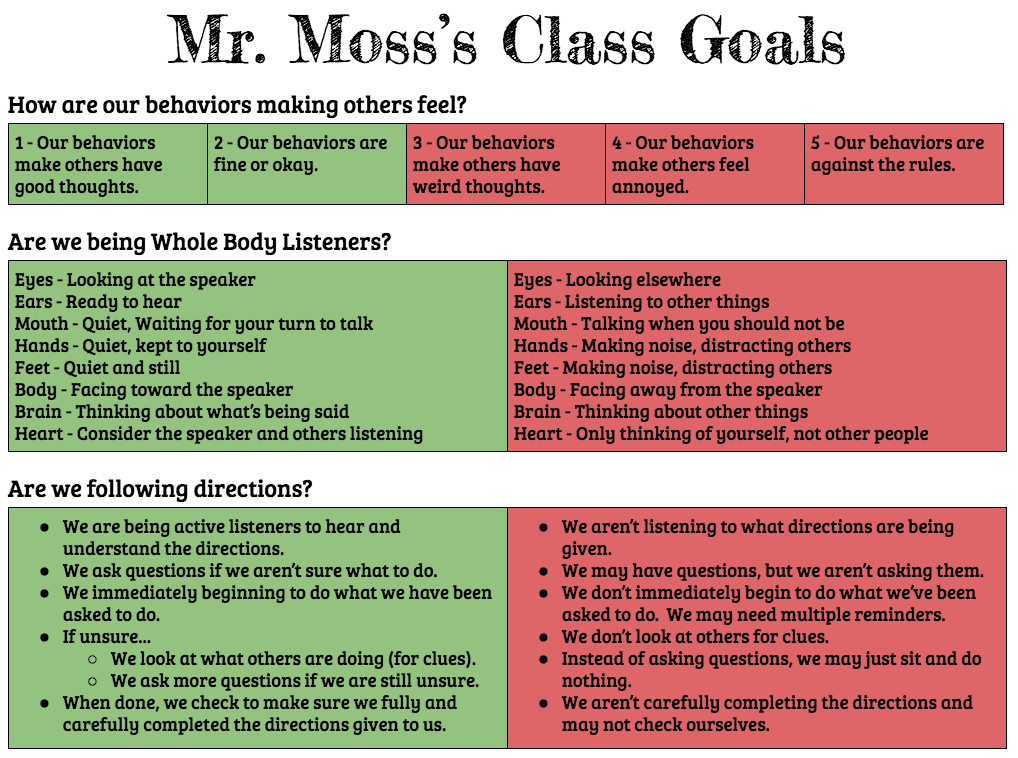 Our new class goals, pictured left, focus on three different areas of our social contract that we (as a group) felt were challenges: respect, focus, and in-control. Using those areas as starting points, we discussed what those qualities looked like and felt like. For “How are our behaviors making others feel?” we use a rating scale that has been very helpful to us throughout the year. Rather than rating the behaviors themselves, this scale focuses on how others feel about our behaviors. Students are VERY familiar with this and can quickly identify whether a behavior is desirable (leading to a 1 or 2 feeling in others) or undesirable (resulting in a 3, 4, or 5 feeling in others). This rating scale came from the game “Should I or Shouldn’t It?”, by Social Thinking, which poses social situations that students must respond to. Some are black and white, like feeling hungry, and taking a snack off a friend’s desk. (A 4 or 5 for sure!) But others are quite a bit more gray, like hearing the doorbell ring and opening the door on your own because your mom didn’t hear it in the other room. (Is it a 1 or 2 because you helped your mom by answering the door? Is it a 5 because you aren’t allowed to open the door? Somewhere in between?)
Our new class goals, pictured left, focus on three different areas of our social contract that we (as a group) felt were challenges: respect, focus, and in-control. Using those areas as starting points, we discussed what those qualities looked like and felt like. For “How are our behaviors making others feel?” we use a rating scale that has been very helpful to us throughout the year. Rather than rating the behaviors themselves, this scale focuses on how others feel about our behaviors. Students are VERY familiar with this and can quickly identify whether a behavior is desirable (leading to a 1 or 2 feeling in others) or undesirable (resulting in a 3, 4, or 5 feeling in others). This rating scale came from the game “Should I or Shouldn’t It?”, by Social Thinking, which poses social situations that students must respond to. Some are black and white, like feeling hungry, and taking a snack off a friend’s desk. (A 4 or 5 for sure!) But others are quite a bit more gray, like hearing the doorbell ring and opening the door on your own because your mom didn’t hear it in the other room. (Is it a 1 or 2 because you helped your mom by answering the door? Is it a 5 because you aren’t allowed to open the door? Somewhere in between?)
The second goal focuses on whole body listening. While that may sound silly to you, it’s helpful in showing students exactly what’s expected of them. (We have a dandy poster in class that lists these qualities in a more visually clear, approachable manner.) Finally, the third goal focuses on following directions, which should be self-explanatory.
So while you may look at these goals and find yourself taken aback by all the wording, please understand that these ideas are very familiar to students, and they typically don’t NEED to review the detailed language. Unified arts teachers have reported to me that their times with our class have also improved since we started using these goals. (They all have their own copies to use with our students.)
At the end of an activity, we reflect on how the activity went. We discuss the choices students made (as a group) and how everyone felt based on the behaviors of those around them. (Again, this may sound a bit cheesy, but it’s working!) If we agree that the class fell into the green zone for all three questions, the class earns a point.
Points
Small goals help students to see the success of their choices on a more consistent basis. When we started this, we identified the number of opportunities students have on a given day to earn points, and we estimated that the class can potentially earn as many as eight or nine points on a given day. So, to start, we set a goal of 25 points for earning a pajama day! Little did I know how quickly we’d reach our goal, and the kids earned their points right near our school-organized pajama day fundraiser for CCMC. So we switched to popsicles. (I confess, I’ve been dragging my heels on this. It took me a few days to get the popsicles, and then after being out for a death in the family, vacation, and the snow days, we haven’t yet gotten to enjoy the treats. This week for sure!) Now, students are working to earn 50 points for a movie opportunity! The speed at which the class earns points has slowed a bit as the novelty has worn off (and that’s entirely typical), but we’re getting there!
Blurt Blocks
Our class is a community, and in that spirit, I like to focus on class successes. That’s why the group earns points for overall success. But I recognize that it’s important for students to be individually accountable as well. I continue to offer chance tickets to students who are making admirable choices in class, but I added in something new to support students when they’re not making appropriate choices: Blurt Blocks. If a student isn’t acting appropriately in class, I give him or her a Blurt Block. They’re little plastic blocks, and if a student receives a Blurt Block, they have to hold them in their hand (or keep them close by, if they need their hands for a learning activity). These aren’t intended to be an embarrassment for students. Rather, they serve as a tangible reminder that the student needs to change his or her behavior. If a student receives two Blurt Blocks during a single activity, he or she completed a letter home to his/her parent(s) about what happened and what needs to improve. That letter must be signed and returned to school the next day. At the end of an activity, when we look at whether we met our goals, students return any Blurt Blocks they received and start fresh for the next activity.
Overall, these three new approaches have been very helpful in improving our class environment. The overall mood in the classroom is more peaceful and focused, and we’ve been much more productive in recent weeks.
If you have any questions about our new approaches, please feel free to contact me.
Posted in Class Updates|By Jon Moss
September 12, 2016
Video and Slides from Curriculum Night
Click here to download the PDF of my 2016-2017 Curriculum Night presentation!
Posted in Class Updates|By Jon Moss
August 28, 2015
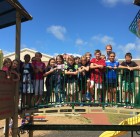
Happy Friday!
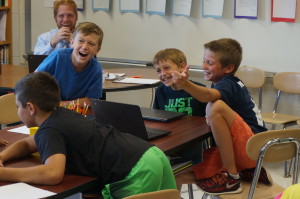 We have started off the year with three terrific days in room 209! The start of school can be a challenging transition for students, and Mr. Walmer and I have worked hard to make our classroom a welcoming community for all 22 new fourth graders. Of course, we did the usual activities with learning classroom routines, students attended their first music, library, Spanish, and wellness classes, and we participated in our school’s traditional first day bell-ringing ceremony. I’d like to take the opportunity to share with you four other activities we’ve been working on this week.
We have started off the year with three terrific days in room 209! The start of school can be a challenging transition for students, and Mr. Walmer and I have worked hard to make our classroom a welcoming community for all 22 new fourth graders. Of course, we did the usual activities with learning classroom routines, students attended their first music, library, Spanish, and wellness classes, and we participated in our school’s traditional first day bell-ringing ceremony. I’d like to take the opportunity to share with you four other activities we’ve been working on this week.
Social Contract
In lieu of class rules, we have worked together to brainstorm ways we want to be treated. Specifically, students answered four questions:
- How do we want to be treated by our teachers?
- How do our teachers want to be treated by us?
- How do we want to treat each other?
- How do we want to treat each other when there is a conflict?
In answering these questions, students generated lists of ideas that describe how we should treat others in the classroom. Some words/phrases, such as “respectfully” and “fairly” appeared as answers to multiple questions, so these will likely be emphasized in our final social contract (which I hope to finish early next week). The social contract is a terrific resource, because we all hold one another accountable to fulfill what we agree to do (when we all sign it.) So if a student is, for example, disturbing others during a lesson, I can refer back to the social contract by saying something like “Hey, Timmy, when you signed the social contract, you agreed to be helpful. When you’re making funny faces, are you helping your classmates to learn? You also promised to be respectful to others. I’ve asked you a few times to focus on the lesson, and I noticed that your friend asked you not to distract her as well. Are you respecting your friend and me when you keep doing that?” Using the social contract helps students to adjust their choices and see why poor choices affect others negatively, rather than just “getting in trouble.”
Chromebooks and Google Classroom
I love using technology in our classroom when it allows students to interact or think at a deeper level, when it makes some of our classroom processes more efficient, or when it is a motivator to students. Yesterday, students got their first opportunity of the year to work on Chromebooks and to log into our Google Classroom page. Kids completed an exercise to prepare for our Two Truths and a Lie activity (see below), and today, students started writing letters to their future selves (at the end of this year) about their goals, predictions, worries, and hopes for the year to come. I’ll share a lot more information with you in the coming weeks, but in the interest of clarity please note that (a) students should always share their Google login information with their grownups at home, and (b) students should NOT be using their school Google email accounts at all right now.
Two Truths and a Lie
Yesterday, students wrote th ree statements about themselves in a Google Doc activity; two of the statements were true, and one was a lie. Last night, I imported those statements into a game environment called Kahoot, which creates a quiz game based on the content I import. We played this game this afternoon, and the kids really
ree statements about themselves in a Google Doc activity; two of the statements were true, and one was a lie. Last night, I imported those statements into a game environment called Kahoot, which creates a quiz game based on the content I import. We played this game this afternoon, and the kids really 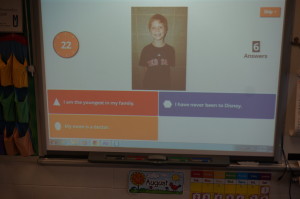 enjoyed learning more about their classmates in a fun and unique way! Plus, the gameshow-like interface of Kahoot created a friendly competition in our classroom. We’ll definitely use this tool more in the future!
enjoyed learning more about their classmates in a fun and unique way! Plus, the gameshow-like interface of Kahoot created a friendly competition in our classroom. We’ll definitely use this tool more in the future!
Readers’ Workshop
Reading lessons started on Thursday! In fourth grade, our reading instruction is inspired by Readers’ Workshop, which is an instructional philosophy that the best literacy instruction is delivered in small bundles, with plenty of opportunity to practice skills as a whole class, in small groups, and individually. Our lessons started with an introduction to our classroom library and book bins, and continued today with a lesson about what silent reading should look like and sound like.
Alliterative Adjective Greetings
You may have noticed that your son or daughter came home on Wednesday with an assignment to think of an adjective that either starts with the same letter as his or her first name and/or with the same sound as his or her first name. Today, students greeted their classmates at their table groups with their nicknames, and we added some challenge by asking students to race to pass around a foam ball while greeting their table-mates, sometimes while skipping around!
Posted in Class Updates|By Jon Moss
October 2, 2014
Our Social Contract (Classroom Community – Part 2)
In a recent post, I wrote about how we work to build a cohesive classroom community in our room. In this post, I will share our classroom’s social contract with you, as well as explain how we help one another to live up to the contract. In early August, I attended the Capturing Kids’ 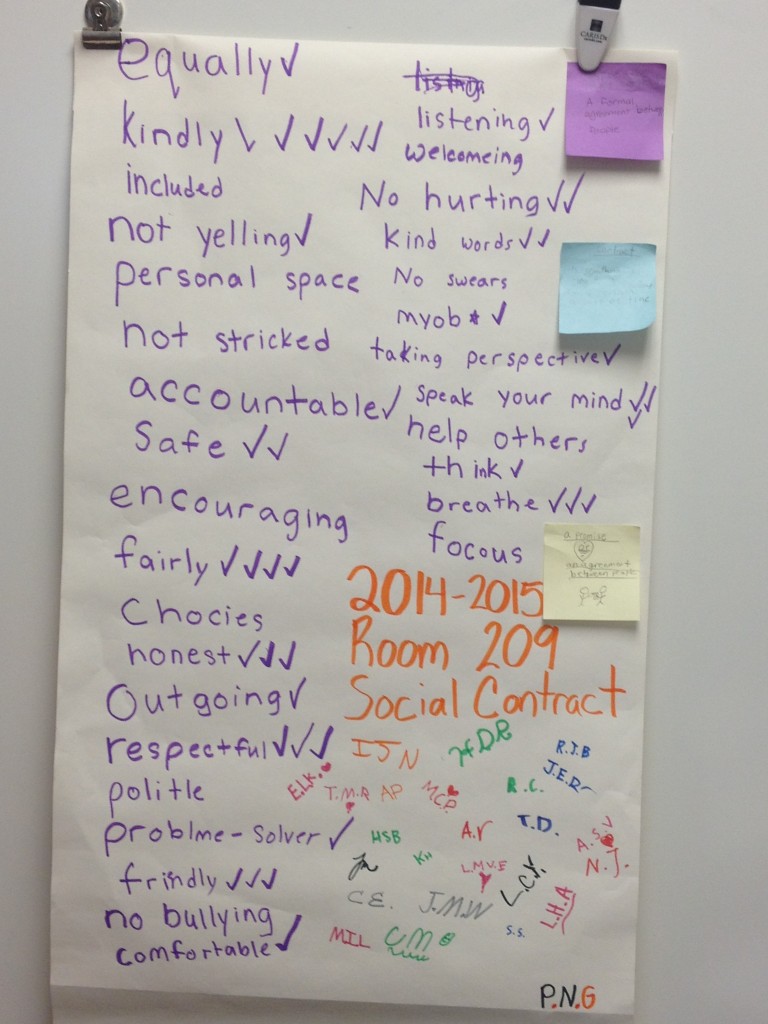 Hearts workshop (which I described in the previous post). One substantial focus of the workshop was the concept of using a social contract. This document outlines how students want to be treated by teachers, how teachers want to be treated by students, how students want to be treated by one another, and how we all want to be treated by either during a conflict. After brainstorming descriptors over the first few weeks of school, groups of students shared out their ideas, and we made a master list as a class. As descriptors were repeated, we added checks to the list. We didn’t distinguish between the four categories I listed because it became apparent (by design) that the descriptions we found were applicable in all instances.
Hearts workshop (which I described in the previous post). One substantial focus of the workshop was the concept of using a social contract. This document outlines how students want to be treated by teachers, how teachers want to be treated by students, how students want to be treated by one another, and how we all want to be treated by either during a conflict. After brainstorming descriptors over the first few weeks of school, groups of students shared out their ideas, and we made a master list as a class. As descriptors were repeated, we added checks to the list. We didn’t distinguish between the four categories I listed because it became apparent (by design) that the descriptions we found were applicable in all instances.
I must tell you how very impressed I was by the depth of thought that the kids put into their brainstorming. As you can see from our social contract, some ideas were common themes in our discussion: kindness, fairness, honesty, respect, friendliness, safety, candor, patience, and more! All students chose to sign the contract as their agreement to try to live up to the document. (This wasn’t mandatory – everyone CHOSE to get “on board” with the contract.)
One reminder that I give to the class is that we will not be perfect in following the contract. There are days when we all make mistakes, and what’s important is that we work to make the best choices we possibly can, rather than being perfect. The word “accountable” only came up twice, but I think we’ve found that it’s become one of the most important words in the contract as it’s been put to use.
When students (or I, for that matter) don’t live up to the social contract, we use the document to help us to problem solve. Rather than discussions taking the tone of “You are breaking the rules. You may not do that.” or “You’re not allowed to take things of ___’s desk.” we can instead refer back to the social contract. Conversations have a more positive tone, such as: “Billy, we all agreed to follow the social contract so that everyone can learn in a comfortable, safe environment. We agreed to treat each other kindly. You signed this contract, and we all need to work hard to be successful. When you _________, do you think it helped _______ to feel respected? … How could we help ____ to feel respected?” Notice how I use words from the contract in that example – it’s a document that the kids generated, so they have a great sense of ownership over it. They want to live up to the social contract.
The reality, of course, is that we won’t always be successful. Part of building a classroom community involves empowering students to help one another to be successful. When they see another student not making good choices, they’re encouraged to use a gesture – a wiggling fist, with the thumb extended upward – to help their peer to make a better choice. This isn’t a way of tattling on a classmate to me, indeed, I tell the kids that this works best when I have no idea that it’s happening. The best metaphor is a baseball connection. When a player is having a rough time at a game and gets in the umpire’s face to scream, his fellow players run up and often hold him back and bring him back to the dugout. Why? Because they want to keep their teammate in the game, working to help the team to win. It’s the same idea in our class – using the thumb gesture is intended to help a peer to make better choices so that they can stay “in the game” and keep our whole class successful.
When poor choices continue, we do need to rely on classroom consequences. But like the social contract, these were student-generated. We talked about the difference between punishments and consequences, and that punishments are designed to be punitive, while consequences are simply the effects that follow a choice we make. When you look at our list of consequences, you’ll see that many of the kids’ ideas were more like punishments (listed in purple) rather than consequences (yellow highlighting). I believe in logical consequences – making sure that the consequence is connected to the choices that the student made. Items in green can happen anytime, but you’ll see that students will be given a warning and then asked to take a time out before having to visit the office.
In the next post (the third and final in the series), I’ll tell you a bit about some of the ways I help students to motivate themselves to make the best choices they can! Stay tuned!
Posted in Class Updates|By Jon Moss
